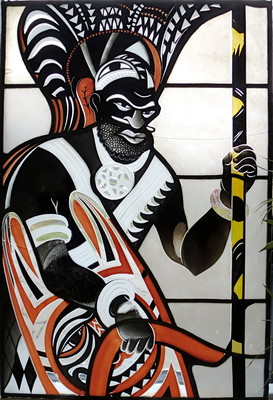Cesar Klein (1876-1954)
Gottfried Heinersdorff (1883-1941)
Allegory of Australasia
Designed and made for the Continents Cycle in the Bruno Paul Room of the Grassi-Museum, Leipzig
By Cesar Klein and the Puhl & Wagner / Gottfried Heinersdorff, United Mosaic and Stained Glass Workshops, Berlin, 1927
a) Design on a scale of 1:5, 1927; paper, pencil, watercolour, white highlights; h 16.9cm, w 12.1cm; unsigned
b) Panel - the only survived of three
White occasionally milky flashed glass, painted with black, grey and red-brown glass-paint, as well as yellow stain; ground areas, some deep and round, some blank and grooved; leading; h 86.4cm, w 58.2cm; unsigned
Both pieces are from the estate of the artist's widow Paula Klein
Dokumentation
Between 1925 and 1929, the Grassi-Museum in Leipzig was rebuilt. In 1927, the architect, furniture designer and interior designer Bruno Paul (1874–1968) created a reception room for which Cesar Klein executed five room-height windows, each with a harmonious and varied grid consisting of rectangular glass panels. Set into the middle of each of these grids was a single panel with an allegory of a continent: Europe, America, Africa, Asia and Australia-Oceania. The glazing was destroyed during an air raid in 1943. Only two fragments survive, from the figures of Europe and Asia, and these are in the Grassi-Museum. The Bauhaus in Dessau (which was not far from Leipzig) and pictures by Piet Mondrian (1872–1944) may have been a significant influence in the geometrical framing design, which would therefore allude to the work of Josef Albers (1888–1976), who directed the stained-glass course at the Bauhaus and in 1927 designed the glazing for the staircase of the new Grassi-Museum.
The depiction shows the upper part of a Melanesian man in three-quarter profile, who looks into the distance with a magic gaze. Noteworthy is the eye that appears on the headdress and shield (which is carried on a strap), a reference to the malanggan and a symbol associated with the realm of funerary ceremony and rituals for the dead. As inspiration for his representations of clothing, jewelry and weapons, Klein was able to turn to objects in the Grassi-Museumʼs own collection, focusing predominantly on objects from Oceania, with only the boomerang making reference to Australia. The colour palette of the stained glass is limited to black, white, grey and red-brown. In Melanesia black is the colour of military might, white the colour of the world of the ancestors and the kingdom of the dead, and red that of warning and the earth.
The watercolour design for this glass shows a first version of the theme, which is noticeably different from the panel as executed. While the bearing and colouration of the figure represented were retained for the most part, changes can be detected in the outline of the figure as well as in his accoutrements. Klein probably discovered the eye symbol, which does not appear in the drawing, between the design and execution stages. Klein had long abandoned his expressionist and cubist phase at the time of the Grassi-Museum commission. The drawing features rounder, softer lines. The vertically set spear and the horizontally organized leading render this glass picture’s composition geometrical, demonstrating the artist’s engagement with the Bauhaus.
The panel with an Australasian figure was produced separately in two copies, according to workshop practice: one for the artist and one for the workshop - the latter has gone missing. That this figure was selected for such treatment may indicate that the theme was considered particularly suitable for international exhibitions, at which it would be a good ambassador for the young colonial power that Germany was. With the acquisition of German New Guinea in the South Pacific (in 1899) and of further groups of islands in the mid-Pacific during the reign of Emperor Wilhelm II, commercial and cultural interests in Germany were directed towards Australasia.
Bibliographie
Maria-Katharina Schulz, Glasmalerei der klassischen Moderne in Deutschland, Europäische Hochschulschriften/Publications Universitaires Européennes/European University Studies, Art History, series 28, vol. 74, Frankfurt am Main/Bern/New York etc., 1987, pp. 58–64
Ruth Irmgard Dalinghaus, ʻCesar Kleinʼ, in Helmut Geisert and Elisabeth Moortgat (eds), Wände aus farbigem Glas: Das Archiv der Vereinigten Werkstätten für Mosaik und Glasmalerei Puhl & Wagner, Gottfried Heinersdorff, exhibition catalogue, Berlinische Galerie, Berlin, 1989, pp. 79–93
Museum für Kunsthandwerk Leipzig, Grassi-Museum (ed.), 125 Jahre Museum für Kunsthandwerk Leipzig, Grassi-Museum, II, 1: Die Museumschronik von den Anfängen bis zum Jahr 1929, ed. Olaf Thormann with Ute Camphausen, Eva Maria Hoyer, Eberhard Patzig, Uta Petter et al., Leipzig, 2003, pp. 192f. and p. 223
Hermann Mückler et al. (eds), Ozeanien: 18. bis 20. Jahrhundert. Geschichte und Gesellschaft, Vienna, 2009, passim, with illustrations
The panel appeared in the 2011 exhibition Glasmalerei der Moderne: Faszination, Farbe im Gegenlicht at the Badisches Landesmuseum in Karlsruhe from 9 July – 9 October 2011, and was published in the catalogue that accompanied the exhibition (cat. nos. 17a–b, pp. 148f.)
Print
Contact us
Biografie Cesar Klein
Biografie Gottfried Heinersdorff


